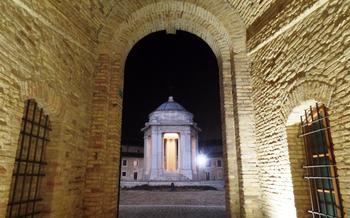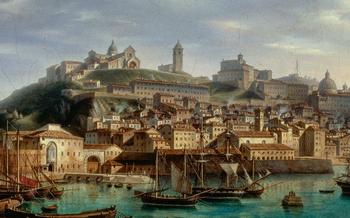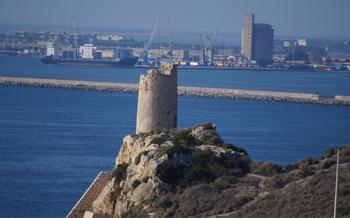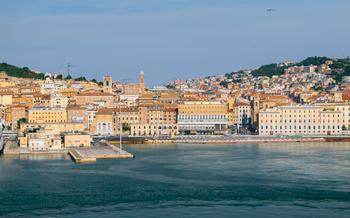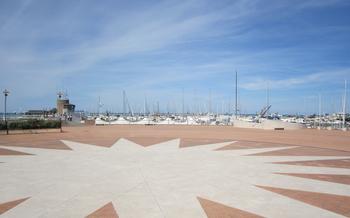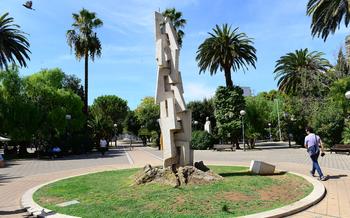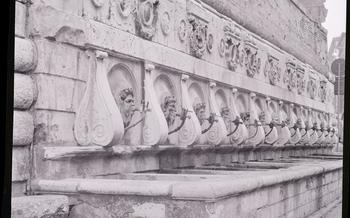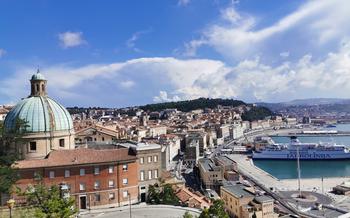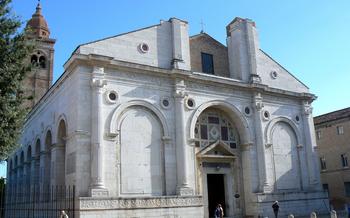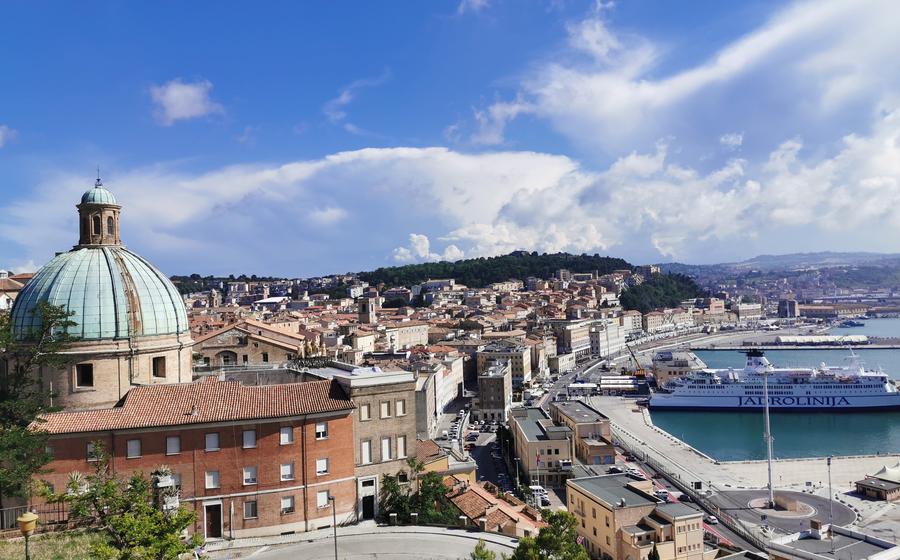
Lazzaretto di Camerano
- Ancona's Fascinating History and the Lazzaretto di Camerano's Significance
- Historical Background
- Architectural Features
- Quarantining Process
- Living Conditions
- Lazzaretto's Role in Ancona's Trade
- Cultural Significance:
- Restoration and Preservation
- Exhibitions and Events
- Guided Tours
- Visiting Hours and Tickets
- Accessibility
- Location and Transportation
Ancona's Fascinating History and the Lazzaretto di Camerano's Significance
Nestled in the picturesque hills surrounding the ancient city of Ancona, the Lazzaretto di Camerano stands as a testament to the city's rich maritime heritage and enduring resilience. Built in the 18th century, this imposing structure served as a quarantine station, playing a crucial role in safeguarding public health during times of rampant contagious diseases. Ancona, with its strategic location on the Adriatic coast, has long been a thriving port city, welcoming ships from across the Mediterranean and beyond. The Lazzaretto di Camerano, therefore, played a pivotal role in ensuring the city's continued prosperity by preventing the spread of deadly diseases that could have crippled its bustling trade and vibrant cosmopolitan atmosphere.
Historical Background
The Lazzaretto di Camerano originated from a dire need to protect the health of Ancona and its surrounding regions during a time when infectious diseases posed a significant threat to maritime trade and public well-being. In the late 15th century, as Ancona thrived as a free port and a bustling maritime hub, the city authorities recognized the urgency of establishing a quarantine facility to safeguard their thriving trade and the health of their citizens.
Ancona's strategic location on the Adriatic Sea made it a crucial gateway for ships carrying goods and passengers from far-off lands, increasing the risk of introducing contagious diseases into the city. The establishment of the Lazzaretto di Camerano served as a proactive measure to prevent the spread of epidemics and to ensure the continued prosperity of Ancona's trade and commerce.
Architectural Features
The Lazzaretto di Camerano stands as an architectural marvel, showcasing a unique blend of defensive and sanitary elements. Built in the Venetian style, it features a central courtyard and tall defensive walls, reflecting its dual role as a defensive outpost and a health facility.
The Lazzaretto's architectural style is characterized by its sturdy construction and practical design. The high walls, equipped with watchtowers and gun embrasures, served as fortifications against potential attacks, while the central courtyard facilitated the efficient movement of people and goods.
The central courtyard, a defining feature of the Lazzaretto, acts as a central hub connecting various sections of the complex. Surrounded by arcades and loggias, it provided a safe and sheltered space for quarantined individuals to socialize, exercise, and receive care.
The defensive walls, an essential element of the Lazzaretto's design, ensured the safety and isolation of the quarantined population. These imposing walls, punctuated by gun embrasures and watchtowers, guarded against unauthorized access and potential attacks, maintaining the integrity of the quarantine system.
Quarantining Process
The Lazzaretto di Camerano served as a crucial quarantine facility during outbreaks of contagious diseases, particularly during the plague pandemics that ravaged Europe. Ships arriving in Ancona carrying suspected cases of infectious diseases were directed to the Lazzaretto for isolation and observation. Upon entering the Lazzaretto, passengers and crew members underwent a rigorous quarantine process. They were confined to designated quarters within the facility, often in small, cramped rooms, and their movements were strictly restricted to prevent the spread of infection.
During the quarantine period, which could last anywhere from 20 to 40 days, the individuals were closely monitored by health officials. Daily check-ups were conducted to assess their health status, and any signs of illness were promptly addressed. In cases where individuals exhibited symptoms of a contagious disease, they were isolated in separate infirmary wards within the Lazzaretto to prevent further transmission.
To ensure the effectiveness of the quarantine, strict protocols were implemented. All goods and belongings brought by the quarantined individuals were thoroughly disinfected, and any potentially contaminated items were destroyed. Communication with the outside world was limited to minimize the risk of spreading infection. Guards patrolled the perimeter of the Lazzaretto, ensuring that no one entered or left without proper authorization.
Despite the challenging conditions and isolation, the quarantine process played a vital role in controlling the spread of contagious diseases and protecting the health of the population. The Lazzaretto di Camerano served as a crucial barrier against the introduction of deadly diseases into Ancona and the surrounding region, helping to safeguard public health during a time when medical knowledge and treatments were limited.
Living Conditions
Life within the walls of the Lazzaretto was a stark contrast to the vibrant buzz of Ancona's bustling port. The quarantined individuals faced a multitude of challenges and hardships during their period of isolation.
Their daily routine was strictly regimented, governed by the need to prevent the spread of disease. They were confined to their designated quarters, with limited opportunities for social interaction. The lack of human contact, coupled with the uncertainty of their fate, weighed heavily on their minds.
Despite the trying circumstances, the quarantined individuals found ways to cope and maintain a sense of normalcy. They engaged in various activities to occupy their time, such as reading, writing, and playing games. Some even managed to form friendships and bonds with their fellow detainees, finding solace in shared experiences.
The living conditions within the Lazzaretto were often harsh and unforgiving. The cramped quarters and poor sanitation contributed to the spread of disease, posing a constant threat to the health of the quarantined individuals. They endured the discomfort of overcrowding and the lack of privacy, as well as the constant fear of contracting an incurable illness.
Lazzaretto's Role in Ancona's Trade
The Lazzaretto di Camerano was not merely a site for quarantining ships and people but also played a crucial role in Ancona's trade and economy. As a free port and maritime center, Ancona thrived on the exchange of goods and services with various regions and countries. The lazzaretto served as a vital link in this network, facilitating the safe and efficient movement of trade.
Stringent regulations were in place to ensure that ships and goods entering Ancona's port adhered to strict health protocols. Vessels suspected of carrying contagious diseases were required to undergo quarantine before being allowed to dock. This not only protected the health of the local population but also maintained the city's reputation as a reliable and secure trading hub.
By preventing the spread of disease, the lazzaretto helped safeguard Ancona's economic interests. Minimizing the risk of epidemics and disruptions to trade allowed the city to maintain its status as a thriving commercial center. The lazzaretto's role in safeguarding public health and facilitating trade contributed significantly to Ancona's overall prosperity and economic growth.
Cultural Significance:
The Lazzaretto di Camerano has significantly impacted Ancona's identity and culture. As a unique historical relic, it has been immortalized in historical records and documentation, serving as a reminder of the city's resilience and perseverance in the face of adversity. Over time, the Lazzaretto has become a symbol of Ancona's enduring spirit and its ability to triumph over the challenges of the past.
Moreover, the Lazzaretto has contributed to Ancona's cultural heritage through its various artistic expressions. Remains of frescoes and inscriptions adorning its walls hint at the artistic talents harbored within the quarantine walls. These artworks not only beautified the surroundings but also served as a form of self-expression for the quarantined individuals, leaving behind a testament to their creativity and resilience.
Restoration and Preservation
The Lazzaretto di Camerano's state of disrepair prompted collaborative efforts to restore its historical splendor. The restoration process, undertaken by skilled craftsmen and architects, involved several challenges. One major hurdle was the need to maintain the integrity of the original structure while incorporating modern safety and accessibility features. Specialized techniques were employed to reinforce the defensive walls and restore damaged architectural elements, ensuring the preservation of the Lazzaretto's authenticity. The meticulous restoration project aimed to revive the historical charm of this iconic landmark, breathing new life into its storied past.
Exhibitions and Events
The Lazzaretto is not just a historical landmark; it's also a vibrant cultural hub that hosts various exhibitions, events, and educational programs throughout the year. Temporary art exhibitions showcase the works of local and international artists, immersing visitors in a world of creativity and artistic expression. Cultural events like concerts, plays, and historical reenactments bring the Lazzaretto's past to life, offering an engaging and interactive experience for visitors of all ages.
Educational programs and workshops are regularly organized to provide insights into the history, architecture, and cultural significance of the Lazzaretto. These programs are designed to engage students, history buffs, and anyone interested in delving deeper into the fascinating world of this unique historical site.
Guided Tours
The Lazzaretto di Camerano offers guided tours that provide visitors with an immersive and informative experience. Led by knowledgeable and experienced guides, these tours delve into the history, architecture, and cultural significance of the site.
During the tours, visitors can explore the various sections of the Lazzaretto, including the central courtyard, defensive walls, and quarantine wards. Guides share fascinating stories about the individuals who passed through these walls, the challenges they faced, and the role the Lazzaretto played in Ancona's maritime history.
By participating in a guided tour, visitors gain a deeper understanding of the Lazzaretto's significance and its impact on Ancona's identity and culture. Guides provide insights into the medical practices of the time and the measures taken to prevent the spread of disease. They also highlight the architectural features of the Lazzaretto, its unique design, and how it has withstood the test of time.
Whether you are a history buff, architecture enthusiast, or simply curious about this remarkable site, a guided tour of the Lazzaretto di Camerano is an unforgettable experience that will transport you back in time and leave you with a lasting impression.
Visiting Hours and Tickets
The Lazzaretto di Camerano is open to the public for guided tours, offering a unique opportunity to step back in time and explore this fascinating historical site. Visitors can choose from a variety of guided tours, each providing in-depth insights into the Lazzaretto's history, architecture, and significance.
Visiting hours:
- Tuesday to Sunday: 9:30 am to 12:30 pm and 3:00 pm to 6:00 pm
- Closed on Mondays
Ticket prices:
- Full price: €10
- Reduced price: €8 (for students, seniors, and families)
- Free admission: for children under 6 years old
Online booking:
To avoid disappointment and secure your spot, it is recommended to book tickets online in advance. The Lazzaretto's official website provides a convenient online booking system, allowing visitors to select their preferred date and time for the guided tour.
Insider tip:
For those wishing to experience the Lazzaretto's eerie charm after dark, guided night tours are available upon request. These tours offer a unique perspective on the site's history and provide a glimpse into the lives of those who were quarantined within its walls.
Accessibility
The Lazzaretto di Camerano strives to provide an inclusive environment for visitors of all abilities. The site is wheelchair accessible, featuring designated ramps and elevators to ensure that individuals with mobility challenges can easily navigate the premises. Wheelchair-accessible restrooms are also available within the complex.
Designated parking areas are available for visitors with disabilities, located conveniently near the entrance. These spaces are clearly marked and offer easy access to the site.
Moreover, the Lazzaretto offers educational programs tailored for visitors with disabilities. Specialized tours and activities are designed to accommodate diverse learning styles and sensory preferences, allowing everyone to explore and appreciate the site's rich history.
To further enhance accessibility, the Lazzaretto's staff is trained to assist visitors with disabilities and provide any necessary support. They are dedicated to creating a welcoming and inclusive environment for all guests.
Location and Transportation
Reaching the Lazzaretto di Camerano is a journey through scenic landscapes and historical charm. Nestled on the outskirts of Camerano, just a 15-minute drive from the city of Ancona, the Lazzaretto stands as a testament to the past amidst rolling hills and lush greenery.
To get to the Lazzaretto by car, follow the signs from Ancona towards the Camerano exit. Once in Camerano, continue along Via XX Settembre and turn right onto Via Lazzaretto. The Lazzaretto is situated at the end of this road, inviting you into its intriguing history.
Alternatively, you can take advantage of the convenient public transportation options available. From Ancona, hop on bus number 12, which will take you directly to Camerano. From there, a short walk along Via Lazzaretto will lead you to the gates of the Lazzaretto.
Ample parking space is available near the Lazzaretto, ensuring a hassle-free visit. Designated areas are reserved for visitors with disabilities, making the Lazzaretto accessible to all.
Whether you choose to drive or take public transportation, the journey to the Lazzaretto di Camerano is an experience in itself. Embrace the tranquil countryside scenery and prepare to delve into the depths of history as you approach this remarkable site.
